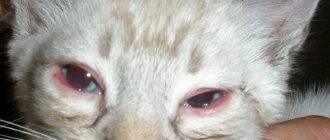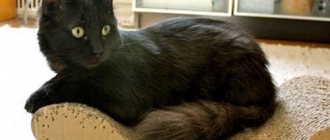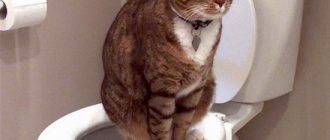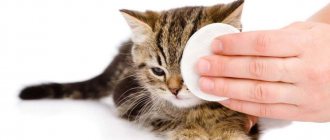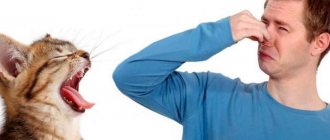Eye diseases in pets are not uncommon. It is important for the owner of the animal to find out why the kitten’s eyes are festering, how to treat the inflammation and how to properly treat the eyelids so that the disease recedes faster. If you notice redness, swelling of the eyes or watery eyes in your pet, you should not hesitate. Lack of treatment can result in damage to the cornea or even loss of vision.
The kitten has conjunctivitis
Causes of pus in a kitten's eyes
Suppuration can be caused by various reasons. The most common is a viral or bacterial infection. Conjunctivitis in a kitten develops when infected with chlamydia, intracellular parasites, streptococci, staphylococci and other pathogenic microbes. They enter the pet's body through contact with sick animals. An infected mother cat can also pass the infection to her cubs.
The kitten's eyes are severely festered due to injury - damage to the eyeball as a result of a blow or a foreign body getting inside. During active games, children often touch each other with thin, sharp claws. If a scratch forms on the eye, then if an infection gets into the wound, inflammation will develop.
Let's look at other reasons why a kitten's eyes become very festered and watery:
- allergy;
- hypothermia;
- pathology of the century;
- irritation of the mucous membrane of the eyeballs from household chemicals;
- blockage of the tear ducts.
Attention! If you do not take into account congenital pathologies of the visual organs, conjunctivitis in kittens always develops due to the inability of the immune system to cope with pathogenic microorganisms - bacteria, viruses and fungi.
Symptoms of eye disease in a cat
Despite the large list of eye diseases in cats, their symptoms are largely similar. You should pay attention to any change in the character and appearance of the pet:
- swelling and redness of the eyelids. Most often they are accompanied by itching, which is very worrying for the pet, which can additionally cause an infection by constantly rubbing its face;
- various secretions. Regardless of the frequency of manifestation (daily, spring-summer, after every sleep) and the purity of lacrimation (transparent, cloudy, purulent). Even “morning tears” should be a reason to contact a veterinarian, as they can be one of the indicators of eye disease in cats;
- change in behavior (aggression, lethargy), absence or painful reaction to light;
- any change in the eyeball and lens. Cloudiness, the presence of a film, strabismus without options indicate eye disease;
- physical changes. Enlargement of the eyeball, inability to close or open the eyelids, enlargement of the third eyelid, tear ducts.
Many eye diseases in cats have specific manifestations, but even they have one of the above symptoms in the description.
The owner’s task is to respond to initial changes in a timely manner.
Symptoms
It is easy to recognize the first symptoms of conjunctivitis in a pet. At first, the kitten's eyes become red and watery. Then the eyelids swell, discharge appears, which forms crusts on the fur. The pet looks depressed and unkempt. In bright light he squints because he feels discomfort.
Redness of the eyelids and discharge of pus
If there is heavy discharge, the kitten’s eyes will not open after sleep, as the pus sticks together the hairs of the fur on the eyelids. The discharge comes in different colors - greenish, yellow, white or brown.
Sometimes eye inflammation is accompanied by general malaise and other alarming symptoms. For example:
- If the eyes fester and the kitten sneezes, the cause of this condition may be chlamydia or toxoplasmosis. In these diseases, the infection affects several body systems at once, except the eyes - the respiratory organs, the digestive tract.
- Purulent eyes, cough with runny nose occurs with mycoplasmosis. The disease develops most often in kittens that are not yet 1 month old. If treatment is not started on time, the infection will affect the liver, genitourinary system, and joints.
- Soreness and swelling of the eyelids in one eye indicates a blockage of the tear duct. This pathology usually occurs in kittens under three weeks of age.
- Purulent discharge from under the eyelids mixed with blood is a sign of injury.
The structure of the organs of vision
The cat's eye consists of 3 shells, each of which performs unique functions in detecting and perceiving light - the visible part of electromagnetic radiation. The general diagram of the structure is shown in the photo.
- The fibrous membrane is the outer layer of the eye, formed from collagen fibers and the protein elastin. It consists of the sclera, which covers 3/4 of the ocular surface area, and the anterior visible part, the transparent cornea, which covers the remaining quarter. The latter is responsible for receiving light and transmitting it to the inside of the eye for subsequent processing.
- The choroid is the middle layer with microscopic blood vessels that supply the eye tissue with nutrients and oxygen. In front of it is the ciliary (ciliary) body, with the help of the muscles of which the eye lens is held in the required position and its shape changes taking into account the distance to the object in question in order to ensure a clearer vision of it (the so-called accommodation process).
In front of the ciliary body is the iris, the colored part of the eye that divides it into outer and inner chambers. Its color depends on the presence of pigment and can be finally formed from 1 month of life to 2 years of age. In the center of the iris there is a black pupil, which changes its size with changes in the level of illumination to regulate the intensity of the light flux entering the eyes: it narrows in bright light, and in gloomy light it expands to let in maximum light.
- The retina (retina) is the inner layer formed of light-sensitive cells that are responsible for converting light into nerve impulses for subsequent transmission to the brain using the optic nerve. Cats, like humans, have two types of photoreceptors:
- rods - provide light reception, pass it through themselves, which forms vision;
- Cones - responsible for image clarity, the ability to see small details and color perception.
It is with the predominance of rods in the retina in cats that their better vision compared to humans in low light is associated, which is necessary for them as animals that are nocturnal. In other respects, the structure of the eyes, as well as the mechanism of their operation, are practically the same.
Near the entrance of the optic nerve from the retina there is an area that is not sensitive to light - the “blind spot”. Photosensitive receptors are completely absent here, so information about the outside world that comes here is simply not perceived. But immediately behind it there is a “yellow body” in the form of a disk - the area of best vision, in which all the light entering the eye is focused. Therefore, animals turn their heads so that the rays end up on this particular part of the retina.
Treatment of eyes for pus in a kitten
If a kitten has red, inflamed eyes, and pus appears in them, you should immediately show him to the veterinarian. It is especially important to visit an animal clinic if eyelid swelling and tearing are accompanied by sneezing, coughing, or intestinal upset. Such symptoms indicate a bacterial or viral infection. Delay can cost your pet's life.
Red eyes and runny nose are a sign of rhinotracheitis
The treatment regimen and course duration are determined by the veterinarian. Therapy may include eyelid rinsing, ointment treatment, and the use of antiviral or antibacterial drops. In some cases, immunotherapy is performed using Cycloferon injections.
Eye drops for cats
Anti-conjunctivitis medications will help eliminate the infection. Depending on the type of pathogen, the veterinarian will prescribe an appropriate remedy to combat the infection.
Anandin
If the cause of suppuration is a virus, Anandin drops will help. They are sold in veterinary pharmacy. The drug also helps fight conjunctivitis caused by an allergic factor. The composition is administered behind the lower eyelid, 2 drops. If the disease is accompanied by rhinitis, it is recommended to instill the product into the nasal passages, 2 drops 2 or 3 times a day.
Tsiprovet
A drug based on ciprofloxacin. Indicated for bacterial conjunctivitis, keratoconjunctivitis, blepharitis caused by intracellular parasites - chlamydia, mycoplasmas, as well as Pseudomonas aeruginosa and staphylococci. The medicine is also used to prevent infection in corneal injuries. Method of use: after cleaning the eyelids, drop 1-2 drops of the composition into each eye, frequency of administration: 4 times a day. The course of treatment is continued until the symptoms disappear, but not more than 14 days.
Ciprovet eye drops
Iris
The drug contains the active ingredient gentamicin, a broad-spectrum antibiotic. Effective against staphylococci, streptococci, Pseudomonas aeruginosa and other bacteria.
Kittens are treated for 5–10 days, depending on the severity of the clinical picture. The recommended dose is 1 drop of the composition under the lower eyelid 3-4 times a day.
Diamond eyes
The active ingredient is chlorhexidine, an antiseptic that has a regenerating and anti-edematous effect. The composition is used for everyday toilet or treatment of conjunctivitis at an early stage. Directions for use and dosage: 2-3 drops in each eye for 10-14 days, 3 times a day.
Leopard
Bars eye drops are a drug containing furatsilin. The substance destroys some types of gram-positive and gram-negative bacteria. It contains novocaine, which helps relieve pain. The drug is used to treat purulent conjunctivitis, blepharitis and keratitis. Dosage for kittens – 2 drops in each eye 4 times a day for 7–10 days.
Phloxal
These drops are sold in a regular pharmacy. They are often prescribed by veterinarians to animals. The active ingredient is ofloxacin. Bacteria are sensitive to it - Klebsiella, streptococci, staphylococci, Escherichia coli, Legionella, Salmonella, etc.
Floxal drops
Floxal is used to treat kittens 2-3 times a day. The duration of the therapeutic course is 7–10 days, depending on the severity of the disease. Dosage – 1 drop per eye under the lower eyelid.
Reference. If the eyes are affected by chlamydia, the course of treatment is extended to 14 days, and the frequency of use is up to 5 times a day.
Ointments for purulent conjunctivitis in kittens
Tetracycline ointment 1%
A drug based on an antibiotic from the tetracycline group. Gram-positive bacteria are sensitive to it - Listeria, Haemophilus influenzae, streptococci, staphylococci, and gram-negative microorganisms - chlamydia, mycoplasma, klebsiella, salmonella, shigella, etc. The ointment is applied under the lower eyelid 2 or 3 times a day.
Phloxal
Ofloxacin-based ointment is used for keratitis, purulent conjunctivitis, corneal ulcers and chlamydial infections. You need to squeeze 0.5 cm of ointment onto your finger and place it under the lower eyelid after hygienic treatment. If the veterinarian has prescribed both drops and ointment, then the liquid product is used first.
Why do my kitten's eyes fester?
Suppuration in the eye area in kittens under 3 months of age is a fairly common problem. Moreover, this is not always associated with the influence of the external environment; most often, kittens are born with a problem that gets worse as the animal grows.
Why do a kitten's eyes fester?
- Chlamydia . Oddly enough, not only people, but also cats suffer from this disease. The disease is usually transmitted to kittens when passing through the mother's birth canal. A cat gives birth to her babies with chlamydia, which is why they have infectious conjunctivitis.
- Follicular conjunctivitis . Occurs when inflammation of the lymph nodes occurs. Along with discharge from the eyes, photophobia and swelling in the eyelid area will be observed. Please note that with this disease, hair around the eyes very often falls out.
- Purulent conjunctivitis . Most often it manifests itself in both eyes; with this disease, the cat experiences not only purulent discharge, but also an elevated temperature. Initially, the discharge from the eye area is very thin, but gradually becomes thick, with a green or yellow tint.
Purulent eye
Is treatment possible at home without veterinary care?
Before you start treating your kitten at home, you need to take him to an appointment with a veterinarian. It is very important to find out the real cause of inflammation. If it is accompanied by a general deterioration in health, sneezing, coughing, and upset bowel movements, the pet may be seriously ill.
Some dangerous diseases, such as calcivirosis or viral rhinotracheitis, often occur with symptoms of damage to the organs of vision. The veterinarian will examine the pet, take tests and make a diagnosis. If a serious infectious disease is detected, eye drops alone cannot be used; complex treatment will be required.
Attention! You can treat a kitten at home only after examination at a veterinary clinic.
How and what to wash a kitten's eyes with
Washing the eyelids is the first thing to do if the inflammatory process begins. You need to carefully remove crusts and discharge with a cotton pad. It is moistened in warm boiled water, saline or strong tea without additives. Each eye is wiped with a clean swab in the direction from the outer corner to the inner. On each side you will need 5-6 cotton pads or gauze pads. Do not dip a dirty swab into the rinsing solution.
Washing a kitten's eyes
A strong infusion of chamomile can also be used to cleanse crusts and pus from the eyelids. This remedy helps relieve inflammation. For brewing, it is better to take the flowers of the plant in bags. For 1 cup of boiling water you will need 4 bags of chamomile. Before using the infusion, it is important to make sure that it is not hot. The washing procedure is done 4–5 times a day.
How to put eye drops on your pet correctly
Dealing with a sick pet, even if it is small, is not so easy. The animal will resist treatment procedures. You may need an assistant to secure your four-legged friend. The cat is placed on its back and its paws are held down. A second person carefully removes the pus from the eyelids. Only after this can you use the drops.
The lower eyelid is pulled back slightly with the thumb, fixing the cat’s head so that it does not twitch. The bottle is kept at a distance of 1 cm from the eyeball, the dropper should not touch the eyelid. Inject the required amount of solution into the formed pocket. Next, do the same with the second eye.
Putting eye drops on a cat
When is veterinary help needed?
In some cases, such diseases can be cured without medical intervention at home. But there are situations when refusing the help of a veterinarian can cost a pet’s life (usually this is due to the need to remove the eyeball):
- development of a purulent process (phlegmon or abscess);
- late stages of glaucoma;
- chemical or thermal burns;
- irreversible traumatic damage.
Surgical treatment is carried out under general anesthesia, after the process is completed, stitches are applied. Depending on the extent of the lesion, the following types of operations are distinguished:
- enucleation (only the eye is removed, the eyelids and muscles remain);
- evicseration (the surgeon cuts out the contents of the eyeball, the outer membrane is not affected);
- exenteration (only the bony walls of the orbit remain).
My grandmother’s cat, who lives in a private house, got into a fight with other cats, as a result of which his lower eyelid was completely turned out: his eye was practically invisible due to the large amount of pus and ichor. We brought the pet to the city to see a veterinarian. At first, the doctor wanted to remove the eye to prevent blood poisoning from developing, but the organ was saved. During the operation, the surgeon stitched the lower eyelid, as a result of which everything returned to normal, but we were warned that the cat could develop a cataract and his vision would completely disappear. Now more than 8 years have passed since this intervention: the cat sees perfectly with the damaged eye.
As a result of the injury, the lower eyelid was completely inverted
Prevention
To prevent your kitten from suffering from conjunctivitis and other eye diseases, you need to keep your eyes clean every day. To do this, use regular saline solution or boiled water. Using a damp cotton pad, gently remove dirt from the eyelids.
It is very important to maintain your pet's immunity. The diet should be varied. The cat's menu includes not only meat, but also vegetables, fermented milk products, and quail eggs. You should protect your four-legged friend from contact with stray animals, as they often suffer from various infections. Vaccination will help prevent infection with dangerous diseases.
If your kitten's eyes are swollen and red, the first thing to do is take him to the vet and find out what is causing the problem. He will prescribe treatment after diagnosis. In most cases, you can get rid of conjunctivitis within a week if you follow all the doctor’s recommendations.
The kitten has snot and festering eyes - reasons: how to treat?
Calcivirus (calcivirosis) is a dangerous viral disease that affects approximately 30% of cats. It is not necessary that the cat be an outdoor cat. The virus can often be carried on clothing or on unwashed hands. The virus can survive on clothes and shoes for about one to two weeks without being introduced into the animal’s body. Therefore, the owner can bring illness from the street. Calcivirus is not dangerous for people, but about a third of cats die from this viral disease and the complications it causes.
Calcivirosis is manifested by the following symptoms:
- Runny nose and sneezing for one to two days.
- Heavy discharge from the eyes. They appear around the third day. The cat's appetite worsens, it may refuse to eat, and its body temperature rises.
- Around the seventh day, small ulcers and stomatitis may appear in the mouth.
The kitten has snot and festering eyes, how to treat:
- Treatment of calcivirosis is antiviral. The animal is given immunomodulators, and concomitant infections that are caused by weakening of the body as a result of exposure to the virus are also treated.
- Very often, cats die from bacterial complications that arise from the virus. Among them are pneumonia, arthritis, arthrosis, dehydration, and kidney failure. These ailments are caused by a virus and its untimely treatment.
- Rashes in the mouth are treated with antiseptics, lubricated with Lugol, and washed with furatsilin solution. Cats are vaccinated against such diseases at a young age. If the cat is outdoors, then the virus can enter the body, because it is transmitted from mother to child.
Conjunctivitis
Kittens' eyes fester and stick together: treatment with traditional methods
There are many ways to cure eye infection in a kitten. The treatment method depends on the original cause. When using the same medications for different ailments, treatment may be ineffective. The easiest way for such purposes is to use neutral agents that will help remove mucus, suppuration, and alleviate the kitten’s condition.
Kittens' eyes fester and stick together, treatment with traditional methods:
- Tea. It is necessary to brew strong tea, without adding fruit, moisten a gauze swab and apply it to the sore eye for a couple of minutes. Wait until the solids are completely dissolved in the tea.
- After this, you need to wipe with a swab from the outer corner of the eye to the inner. After this, you need to take new tampons. New swabs must be used for each eye.
- Chamomile tincture. For these purposes, you need to brew chamomile in the amount of 1 tablespoon of the herb per glass of boiling water. Keep it on low heat for 2 minutes. After this, you need to cool the mixture to a temperature of 20 degrees, moisten a gauze swab or cotton pad in the solution. In the same way, you need to hold it on the kitten’s eyelid for 2 minutes and rub from the outer corner of the eye to the inner one.
Treatment
The kitten's eyes are festering - what should I wash it with?
To wipe the eyes, you can use not only decoctions of medicinal herbs, but also pharmaceutical preparations, which are widely used in surgery and in the treatment of wounds of various origins.
The kitten's eyes are festering, what to wash with:
- Furacilin solution. To prepare the product, you need to dissolve two tablets in 250 ml of hot water and heat almost to a boil, with constant stirring. It is necessary that the tablets dissolve completely. Cool the product to room temperature, soak a cotton pad in it, and wipe the cat’s eyes.
- Potassium permanganate solution. Please note that the liquid should be slightly pink, meaning the solution should be weak. Under no circumstances should a strong solution be used, as it can cause burns to the mucous membrane. A couple of crystals per glass of warm boiled water is enough. In the same way, you need to soak a cotton pad in the resulting solution and wipe your eyes.
- To treat the eyes, you can use ready-made solutions. Among them are Chlorhexidine, Miramistin, Decasan . These solutions are created without the use of alcohol, so they do not cause burns to the mucous membranes or discomfort during treatment. Ready-made products can be purchased at the pharmacy. Choose a solution that is suitable for treating mucous membranes. For example, for Chlorhexidine this is a 0.05% solution. It is necessary to soak a piece of gauze with the product and wipe the kitten’s eyelids from the outer corner of the eye to the inner one. Treatment with such antiseptics is carried out 3 times a day. This removes suppuration and also reduces the kitten's anxiety. After all, suppuration and dry crusts cause discomfort and unpleasant sensations in the animal, so the cat can additionally infect the wound.
Rest
